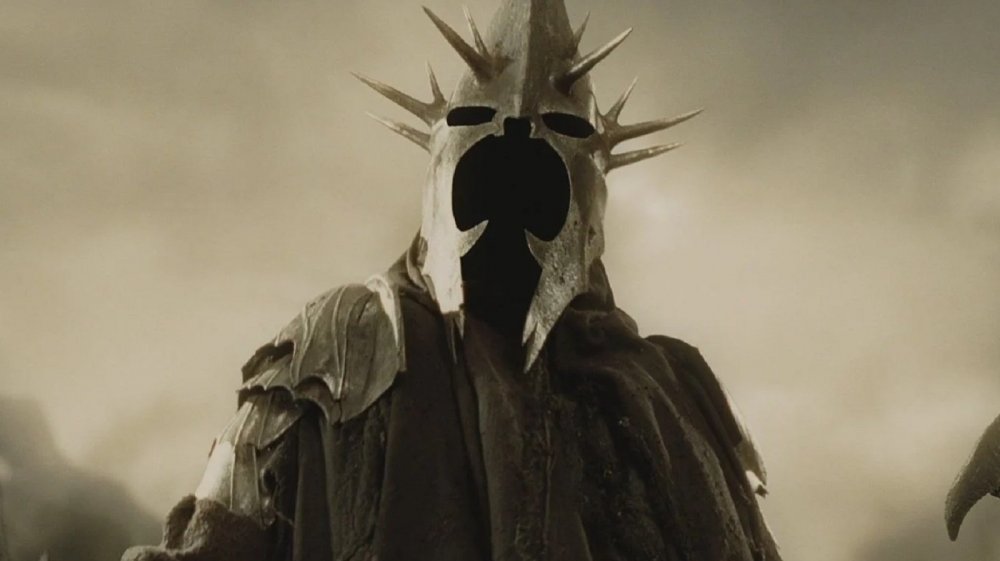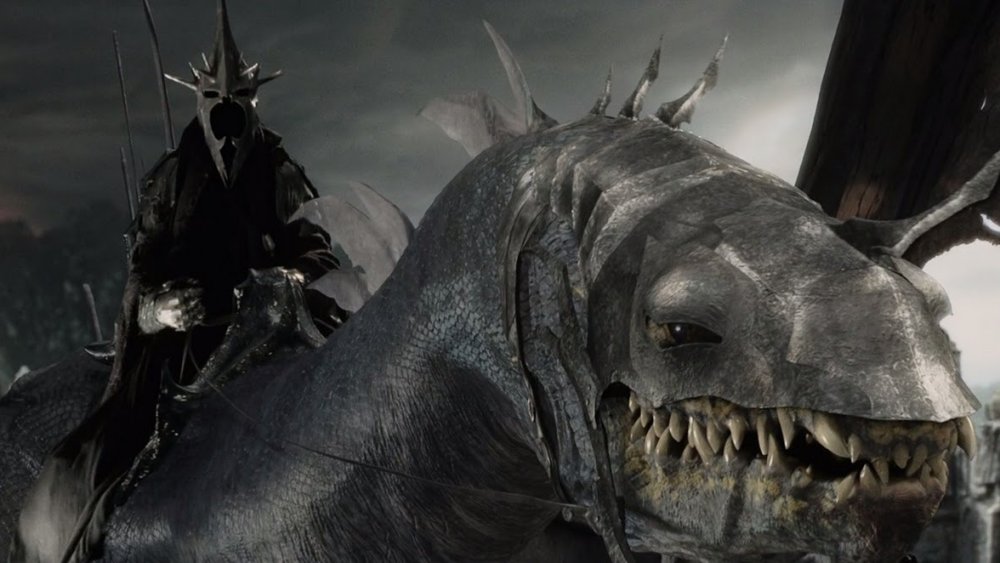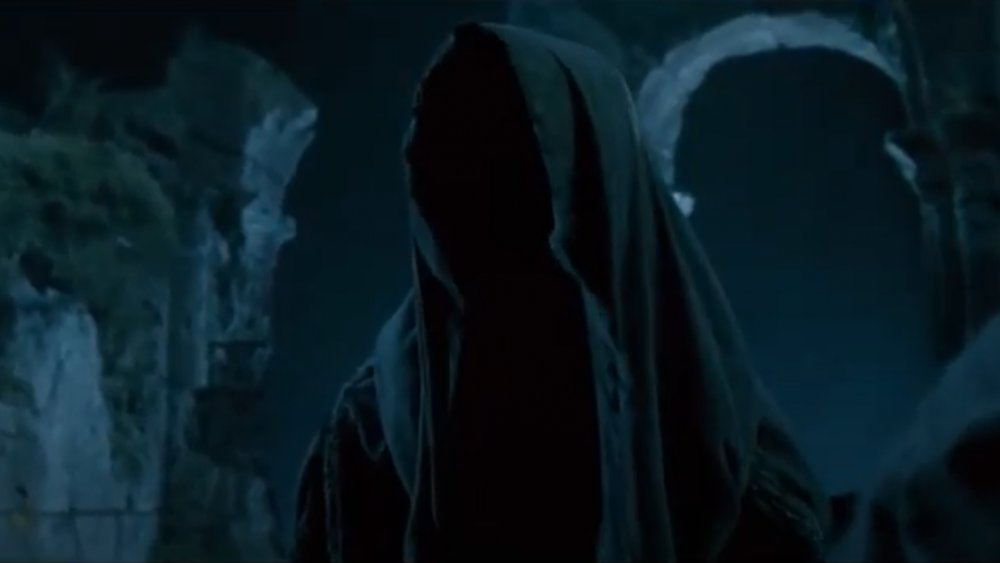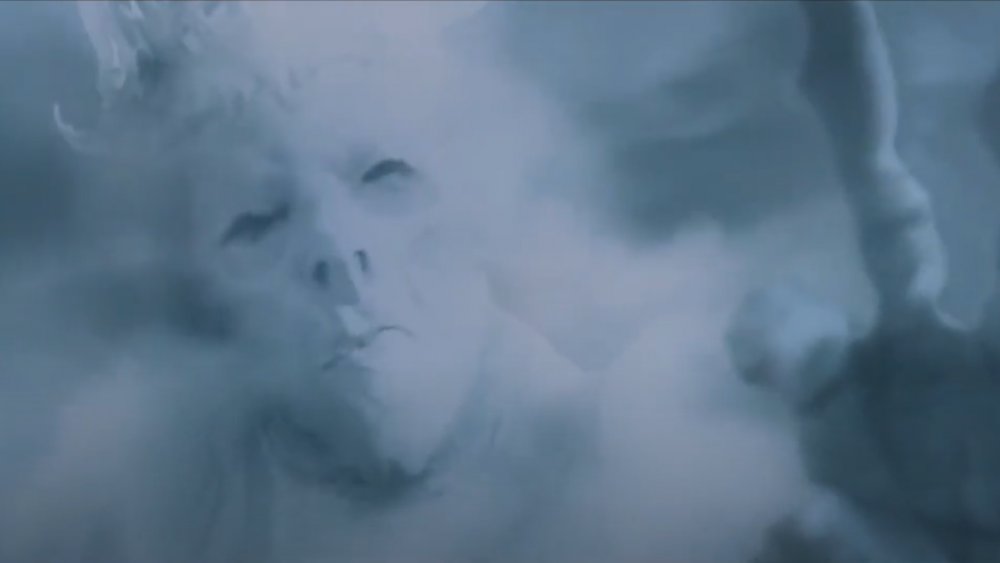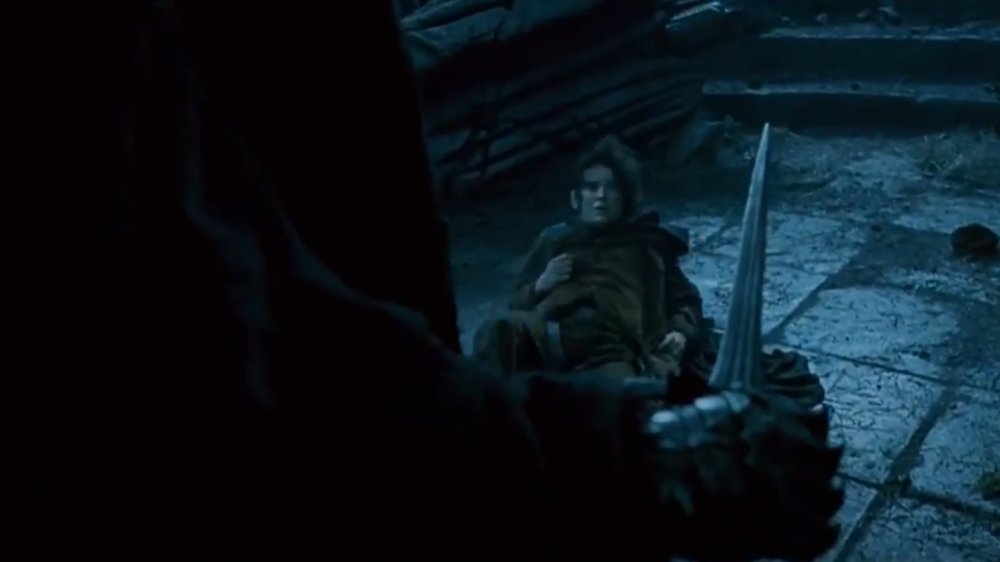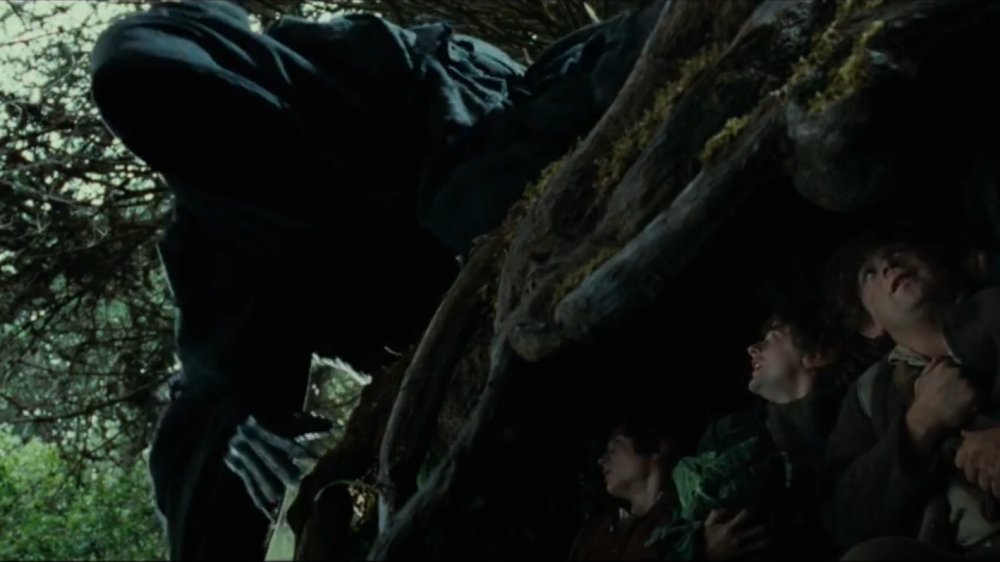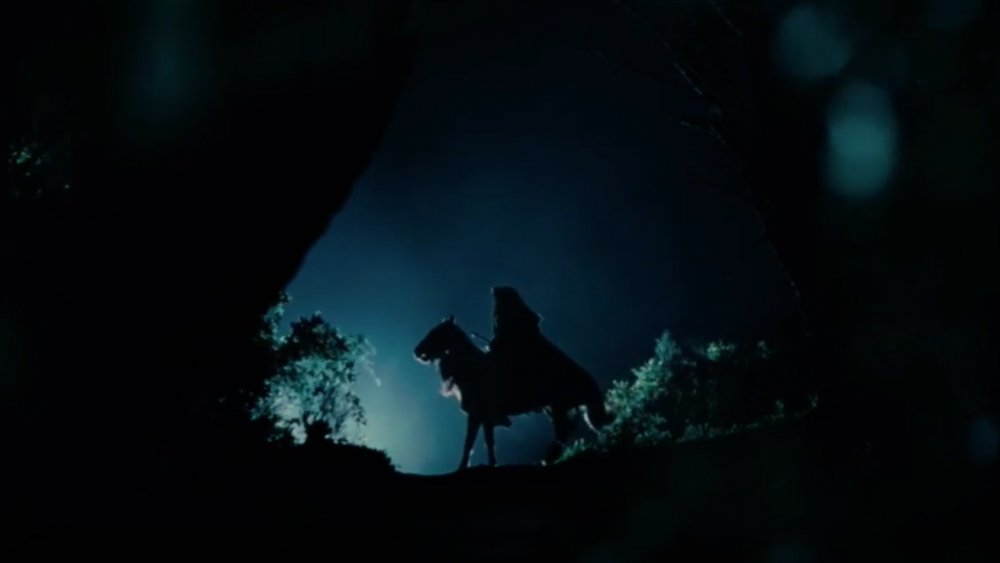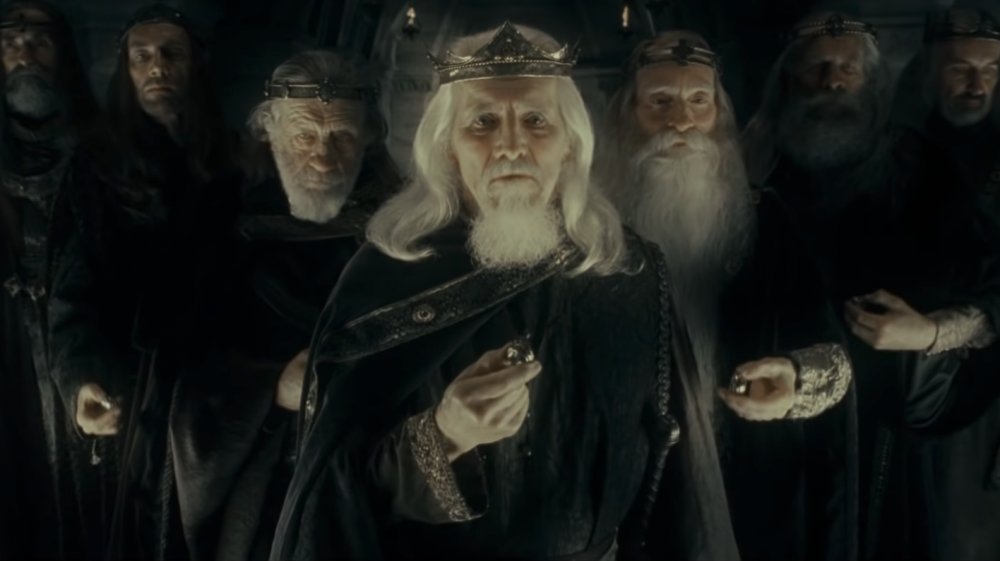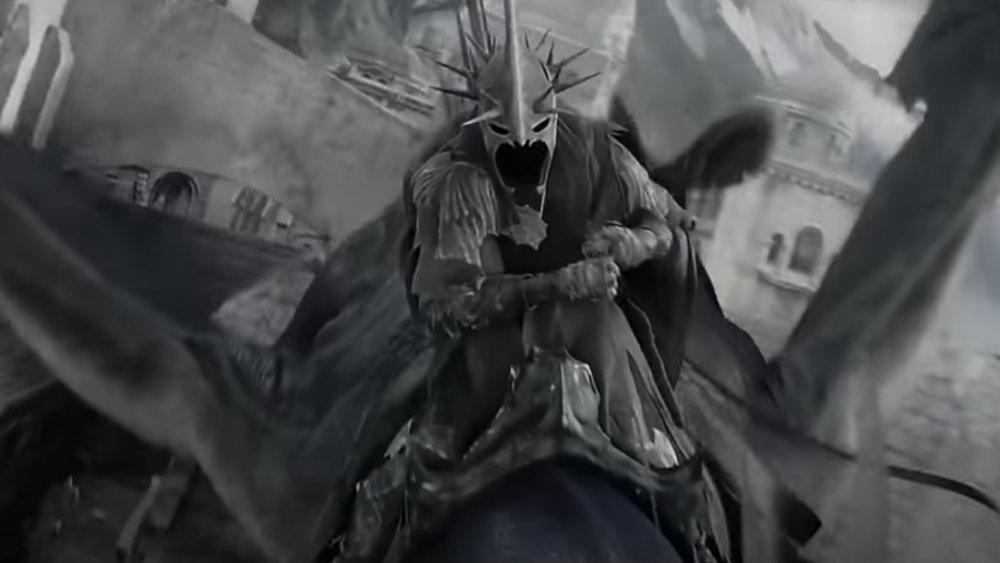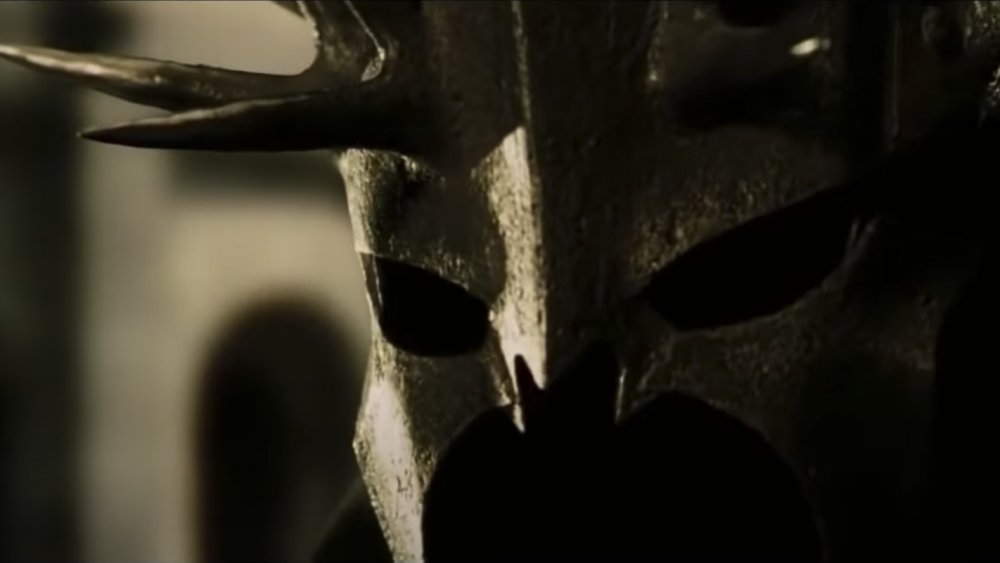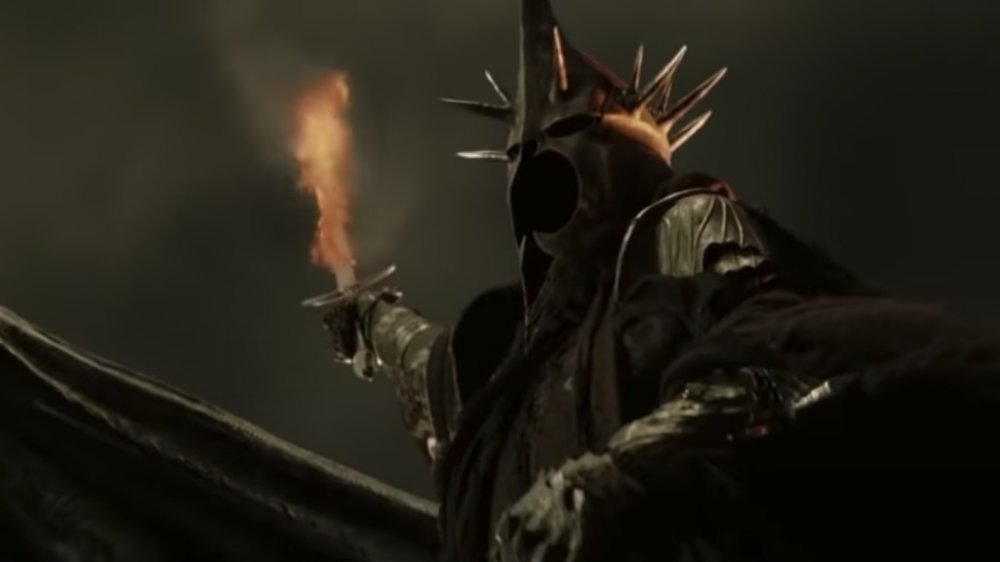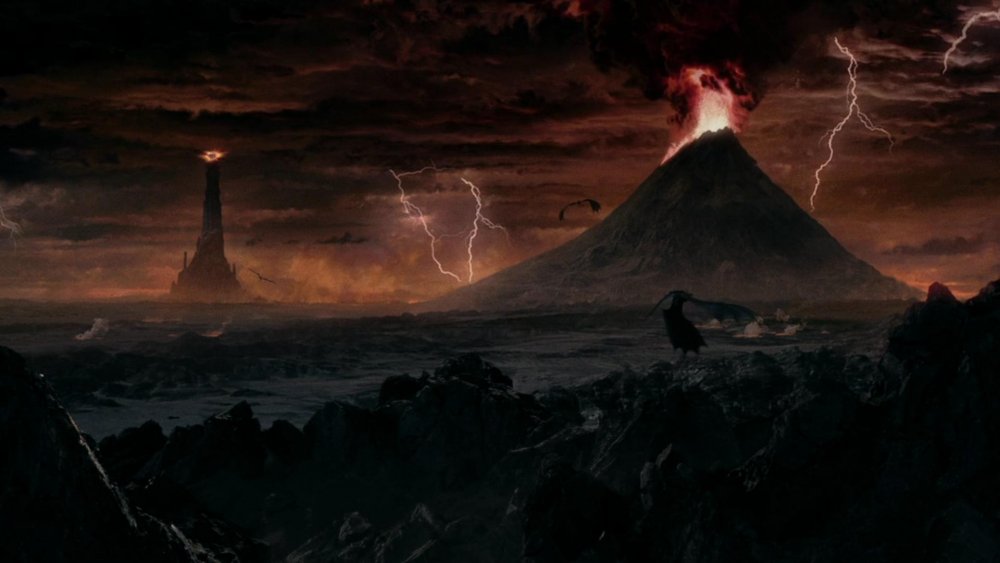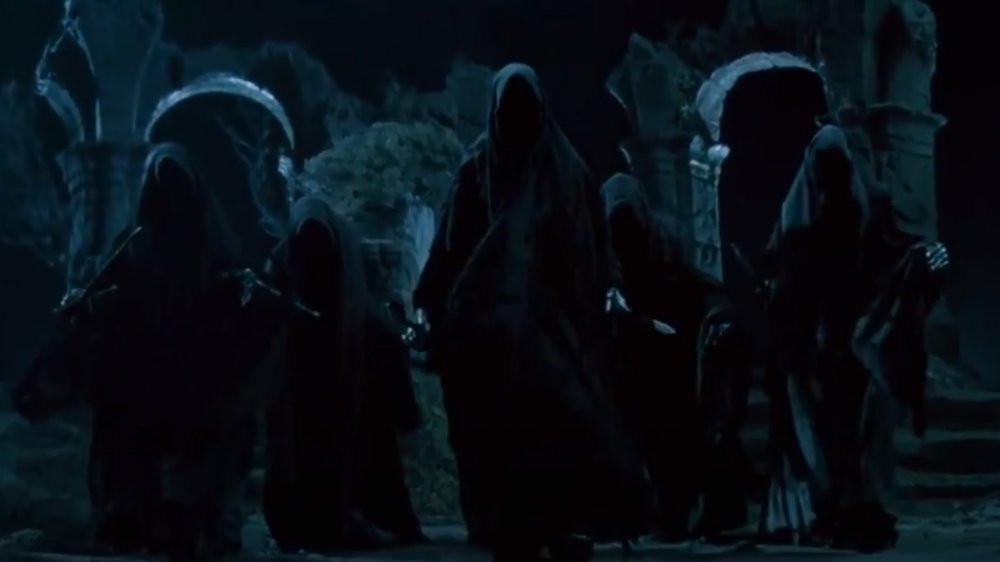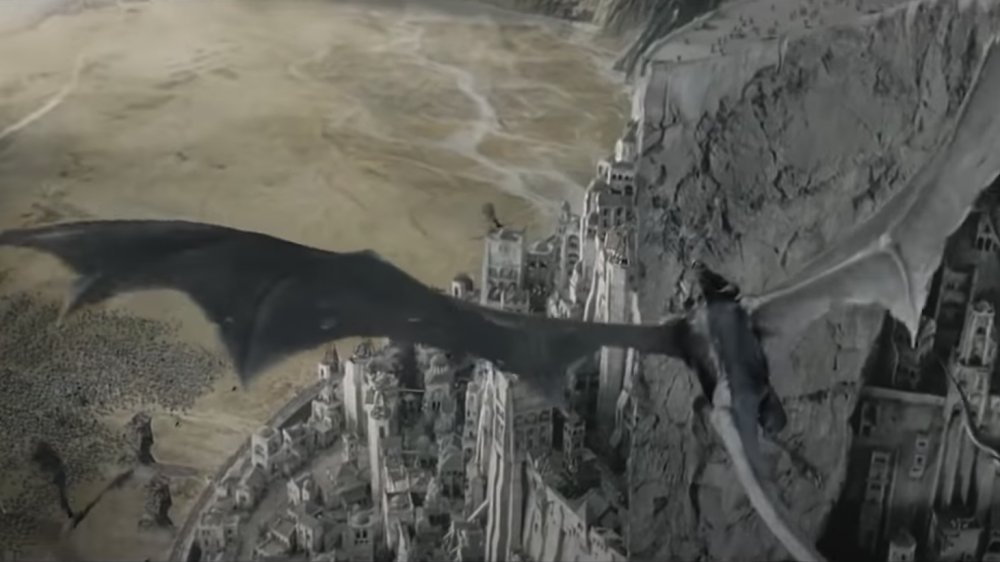The Ringwraiths From The Lord Of The Rings Explained
Middle-earth has its fair share of heroes and villains. Epic warriors like Gandalf, Aragorn, and Éowyn regularly take on a host of baddies that include characters like Saruman, Shelob, and of course, the Nazgûl. The Black Riders are among Tolkien's most fearsome antagonists. And yet, for all of the dread and terror — and ear-splitting shrieking — very little is actually revealed about who the Ringwraiths are. Sure, they're there from day one, hunting the One Ring and flying all over tarnation on their creepy hell-hawks. At the end of the day, though, the Black Riders often feel like little more than plot devices.
Of course, J.R.R. Tolkien was hardly known for creating things purely for the sake of moving a story forward. He developed a background for every single character he invented, including the nine mortal men, doomed to die. So we decided to dig into the background of these mysterious cloaked riders to figure out where they came from, how they operate, and what they were up to before they got tangled up in all of the Lord of the Rings stuff. Here are our disturbing findings, presented for your spine-chilling entertainment.
The Ringwraiths go by many names
The first thing that's worth addressing here is what, exactly, we call these guys. Sauron's most dreadful servants go by several different names as they pop in and out of the story, including, among other things, the Nazgûl, the Ringwraiths, the Black Riders, the Nine, the Fell Riders, the Úlairi, and the Nine Servants. One orc in The Return of the King even refers to them as "filthy Shriekers."
But while the group possesses a slew of appellations, the individual Ringwraiths themselves have always suffered from a severe shortage of individuality. The leader of the bunch is commonly referred to by a few different titles. The Lord of Morgul, Lord of the Nazgûl, and the Witch-king are common, even if they're still just titles. The only Nazgûl to ever be directly named in Tolkien's writings is Khamûl. The index to Unfinished Tales succinctly describes Khamûl as "second to the Chief," "Shadow of the East," and "the Black Easterling," giving a tiny sliver of personality to at least one of these villainous fellas.
The Ringwraiths are crotchety, invisible old men
The Ringwraiths are old — really, really old. In fact, by the time of The Lord of the Rings, these mortal men are probably pushing 5,000 years of age. Their inception likely dates back to roughly halfway through the Second Age, right after Sauron creates the One Ring to rule them all. Each of the Nazgûl receives a Ring of Power around this time (more on that in a bit), which unnaturally extends their lives. Think Gollum's centuries-long transformation from a hobbit-looking creature into a pale, perverted distortion of his former self.
Along with taking the concept of the elderly to a new level, the Ringwraiths also slowly become invisible over the millennia. In The Fellowship of the Ring, Gandalf explains to Frodo why this happens, saying that "a mortal ... who keeps one of the Great Rings, does not die, but he does not grow or obtain more life, he merely continues, until at last every minute is a weariness." The Grey Wizard adds that "if he often uses the Ring to make himself invisible, he ... becomes in the end invisible permanently, and walks in the twilight under the eye of the dark power that rules the Rings." The Nazgûl are the perfect example of this phenomenon, living artificially elongated lives as beings that have, by and large, faded from physical existence.
They're spiritual in nature
Their faded existence means the Ringwraiths don't take up much physical space in the real world. Sure, they can wear clothes, wield weapons, and ride horses, but their primary existence is spiritual in nature. In essence, they dwell in an "unseen" shadow realm through which they dimly interact with the "seen" world. This leads to some of the paranormal phenomena that take place when others come into contact with them.
For instance, when Frodo puts on the Ring, he too enters that spiritual dimension and is able to see the Ringwraiths in all of their otherworldly horror. When Merry and Êowyn stab the Witch-king in battle, both of their arms immediately go numb. Their weapons also disintegrate, with Merry's burning like a piece of wood and Éowyn's breaking into splinters. In the book The Fellowship of the Ring, it's even implied that characters like Gandalf, Aragorn, and Glorfindel are uniquely suited to resist the Riders. This isn't because they hurl flaming brands through the air, Viggo Mortensen-style, but rather because of their stamina and effectiveness in the spiritual realm — a realm that the Ringwraiths are very familiar with.
As a quick footnote, while physical fire does appear to have some effect on the Ringwraiths, it's really water that they seem to abhor. In Unfinished Tales, Tolkien's son, Christopher, says the fear was never really explained, but a healthy respect for that good ol' H2O can certainly be seen as they chase Frodo and company across rivers and through floods.
The Ringwraiths wield powerful weapons
With one foot in the physical world and one on "the other side," the Ringwraiths end up using a smorgasbord of different weapons to get the dirty work done. Some of these are pretty simple — although still terrifying — such as their swords or the Witch-king's giant black mace. But their arsenal boasts much creepier tools than that.
In The Return of the King, the Nazgûl leader uses a "black dart" to kill Théoden's horse, and Aragorn later mysteriously half-explains that their darts kill much faster than the average arrow. And then there's the Morgul-knife that the Witch-king uses to stab Frodo on Weathertop. A notch of the cursed blade embeds itself into the hobbit's shoulder while the rest of the weapon disintegrates. The splinter then begins to worm its way towards Frodo's heart, only being stopped by the timely intervention of Elrond's healing arts. If it had struck home, though, it would've made the hobbit a wraith under their command.
The Ringwraiths also have otherworldly weapons
As bad as the Nazgûls' physical weapons are, they're just trifles compared to the group's unearthly ammunition. While these remain largely mysterious and unexplained throughout Tolkien's writings, the troop wields some mind-melting preternatural weapons that they regularly employ.
For example, there's the simple yet powerfully effective fear factor, a battlefield tactic that would make Joe Rogan proud. The Ringwraiths wield terrifying fear, upsetting people's emotions even from a great distance. In The Return of the King, during the siege of Gondor, it explains that as the riders fly high over Minas Tirith, shrieking and terrifying all below, to their enemies "a blackness came, and they thought no more of war, but only of hiding and of crawling, and of death."
The other, even worse supernatural weapons is the Black Breath. In The Fellowship of the Ring book, Merry first encounters this phenomenon during his visit to Bree when he runs into a Nazgûl and passes out from the overwhelming experience. In The Return of the King, the Black Breath is also connected to the strange sickness called the Black Shadow where victims "fell slowly into an ever deeper dream, and then passed to silence and a deadly cold, and so died." These are some fearsome weapons — perfect for Sauron's chief servants.
The Nazgûls' origins
There's no doubt that the Ringwraiths are absolutely terrifying opponents by the end of the Third Age. The question is, how did they get to the point where they're riding and flying around Middle-earth in black cloaks or leading massive armies into battle? The answer begins way back in the middle of the Second Age.
At this time, Sauron forges the One Ring, captures many of the Rings of Power, and distributes nine of them to "mortal men doomed to die." He chooses so many men because they tend to be easier servants to ensnare than dwarves or elves. While he never explains who all of the nine riders are or where each one comes from, in The Silmarillion, Tolkien reveals that of the Nine, "three were great lords of Númenórean race." That's the same nation that Aragorn's ancestors originally ruled. Khamûl is also mentioned as an Easterling.
After they're given rings, the book also states that the nine initially "became mighty in their day, kings, sorcerers, and warriors of old." In these early days of their Ringwraith careers, they're bathed in glory and become incredibly rich. However, as time begins to creep by, the long-term effects of owning a Ring of Power begin to show up.
The Nine and their rings
In The Silmarillion, we get a sweet and condensed account of the transformation of the Ringwraiths from super-powered human champions to ghoulish servants of Sauron — and it's not pretty. It points out that, sure, they have unending life, but life itself becomes unendurable for them. They can turn invisible with their rings, which seems pretty cool, but they're never hidden from their master.
It takes time for all nine men to slowly slip into creepy Nazgûl thralldom, with each one doing so "sooner or later, according to their native strength and to the good or evil of their wills in the beginning." During this slip into evil, Sauron appears to poke fun at his new captives/servants. One of their unique ring-bearing skills is that the Ringwraiths can see things "in worlds invisible to mortal men." However, it also explains that often what they see is simply "the phantoms and delusions of Sauron." Eventually, they all cave under the pressure, becoming the dreadful Úlairi in the process.
In other words, while we're all used to a conclave of terrifying villains that we just want to see wiped off the face of Middle-earth, the truth is, each of the Black Riders actually starts out as a pretty normal dude. They're lords and leaders who are slowly and tortuously perverted into a state of half-death in which their pure function is to do as the Dark Lord bids them. It's a tragic start to some of Tolkien's vilest creatures.
The Ringwraiths' vague early history
In The Return of the King, it says that the Nazgûl first appear in the larger limelight at some point around the year 2251 of the Second Age. This is roughly 600 years after the One Ring is forged. Very little of their specific activities are mentioned during this part of their history, but the Ringwraiths likely spend the next millennium helping Sauron conquer most of Middle-earth.
Eventually, their great master tussles with the Númenóreans, which leads to the establishment of the new nations of Arnor and Gondor — yes, that Gondor. From there, the action picks up again, ending in the War of the Last Alliance (the events depicted in the opening sequence of The Fellowship of the Ring movie), in which Sauron loses the One Ring and his power is temporarily vanquished.
Alright, you still with us? It's a lot to cover, but the basic takeaway from their early history is that the Nazgûl initially ride the wave to ultimate power with their master. Then Sauron goes up against the Númenóreans, loses his Ring, and is crushed just as the Third Age begins. Throughout all of the action, the Ringwraiths are definitely involved, but they don't show up much in the actual story.
The Third Age begins
After his defeat at the end of the Second Age, Sauron is unable to take on a bodily form for a long time. This leads to a natural lull in evil activity, and as the Third Age kicks off, the Nazgûl initially fade into the shadows and hunker down for a bit. Over time, the shapeless Sauron once again begins to stir, using his most fearful servants — who still remain bound to his will, even without his Ring — as his prime movers and shakers. Even so, it takes some time to get the momentum going again. Roughly a thousand years into the age, things finally begin to pick up, and yes, we're jumping in big time-chunks here, but that's kind of what happens when you're dealing with artificially immortal beings.
At the thousand year mark, the wizards first arrive in Middle-earth with the express task of resisting the resurgent Sauron. The Dark Lord himself secretly reappears on the scene around this time, too, setting up the stronghold of Dol Guldur in southern Mirkwood. The Ringwraiths are most certainly around at this point, and the Dark Lord himself is even suspected of being one of them at this early stage in his second bid for power. However, they don't openly get involved in the action until a little bit later.
The kingdom of Angmar
A few hundred years after Sauron's initial reappearance, the Nazgûl officially re-enter the story. Shortly after they're revealed, the Witch-king sets up the kingdom of Angmar in the northern part of Middle-earth. Then, while his master makes long-term plans and slowly rebuilds his strength, the leader of the Ringwraiths starts a centuries-long war with the local men and elves that inhabit the area. This includes big-shot names like the elves living in Rivendell, the men living in Gondor's sister kingdom of Arnor, and eventually, even the hobbits in the Shire.
The war starts in the year 1409 of the Third Age and lasts for well over 500 years. During this time, Arnor is destroyed, and the hobbits famously lose a troop of archers that they send to help in the fighting. Eventually, though, Gondor sends help, and the Witch-king is defeated — temporarily, at least.
However, just six short years later, the leader of the Ringwraiths pops up in the then-uninhabited waste of Mordor and gathers his eight other ghoulish brethren to him. Then, 20 years later, they attack the Gondorian city of Minas Ithil (the counterpart to Minas Tirith) and capture it. This is the same city that sends up the lightning rod beacon as Frodo, Sam, and Gollum begin to climb towards Shelob's lair. They also capture one of the seeing stones, which explains how Sauron shows up to talk to Saruman, Denethor, Aragorn, and Pippin when they look in other stones down the road.
Prepping Mordor
At this point, the Witch-king have destroyed the kingdom of Arnor — a situation that creates the homeless Rangers that Aragorn rules, we might add — and the Nazgûl have recaptured Mordor for their master. They also own a powerful, fortified city that's practically a stone's throw from the capital of Gondor. They proceed to spend the last millennia before the War of the Ring preparing Mordor for their master. They also slowly chip away at the strength of his enemies, especially Gondor, where they kill the king by luring him into single combat, leaving the stewards to rule the kingdom until another king should return.
Time slowly crawls on until, during the events of The Hobbit, the White Council attacks Dol Guldur and drives Sauron out of his stronghold. However, the Dark Lord only pretends to run away, instead happily heading to Mordor, where his servants have literally spent a thousand years preparing for the biggest welcome home party you've ever seen.
The lead-up to the War of the Ring
After Sauron's return to Mordor, three of the Ringwraiths are sent back to Dol Guldur to mind the shop while their master is away. In Unfinished Tales, it explains that Khamûl is among those tasked with watching the stronghold in Mirkwood.
At a certain point, a messenger from Mordor also arrives at the Lonely Mountain. In The Fellowship of the Ring, Glóin describes him as "a horseman in the night" whose "breath came like the hiss of snakes" — an obvious sign of the Nazgûl. The deadly messenger is sent to the dwarves, offering Rings of Power and asking for news of hobbits and a small ring, a "trifle" that his master fancies, which, sure it is. The dwarves refuse to listen, but the messenger returns more than once, trying to win them over to the Dark Lord's side.
As Sauron picks up on the unfolding situation, he finally decides that if he's going to get the One Ring back, the time has come to play his trump card. He unleashes the Nine Riders in the so-called Hunt for the Ring, an event that neatly coincides with the beginning of the Lord of the Rings story. Interestingly, in The Fellowship of the Ring, one of the Ringwraiths arrives at Bag End just after Frodo and his companions have left. In Unfinished Tales, it's revealed that the Ringwraith is none other than Khamûl himself.
The Ringwraiths and the War of the Ring
The Ringwraiths play a huge role throughout the War of the Ring. Their leader stabs Frodo at Weathertop, and they nearly recapture the One Ring before it gets to Rivendell. They reappear a bit later, flying huge beasts and acting as messengers and generals for Sauron. In the siege of Gondor, they cause terrific destruction before the Witch-king is killed in battle by Éowyn and Merry.
As the armies of the West assault the Black Gate of Mordor, the eight remaining Ringwraiths gather, probably led by Khamûl at this point. They're given one final task when Sauron orders them to hurtle towards Mount Doom to stop Frodo from destroying the One Ring. However, they arrive too late. In The Return of the King, their final moments are described in fiery detail. "The Nazgûl came, shooting like flaming bolts, as caught in the fiery ruin of hill and sky they crackled, withered, and went out," which brings a sudden and long-deserved end to Sauron's greatest servants.
